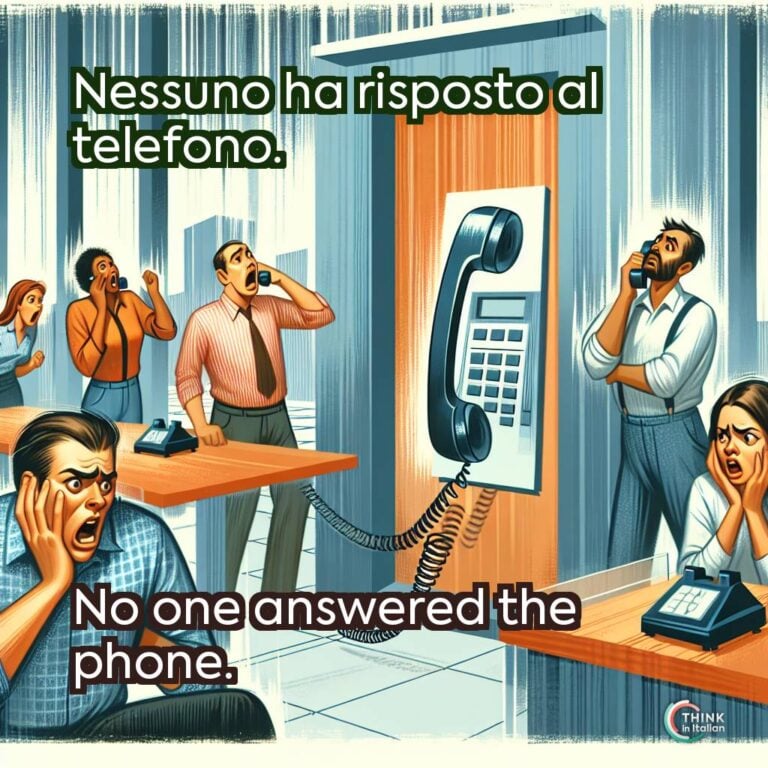Indefinite Pronouns in Italian
In Italian, qualcuno (some, someone), qualcosa (something), nessuno (no one), and niente (nothing) are indefinite pronouns that are used to refer to people or things in a non-specific way.
These pronouns are called indefinite because they refer to an indefinite or unknown entity. They have specific grammatical behaviors that I will explain in detail below.
Meanwhile, let me show you some examples:
C’è qualcuno alla porta.
There is someone at the door.
C’è qualcosa che non va.
Something is wrong.
Non c’è nessuno alla festa oggi.
There is no one at the party today.
Non c’è niente da fare.
There is nothing to do.
Someone, Something, No one, Nothing in Italian
Qualcuno
Qualcuno is used to refer to an undefined quantity of people. It varies in gender but not in number, therefore it has a feminine form – qualcuna– but not a plural.
However, the feminine version is never used as either a subject or an object, but only as a pronoun, for example:
Ho comprato tantissime pesche, prendine qualcuna.
I bought a lot of peaches, take some.
Notice the difference with the following sentences, where qualcuno is instead used as a subject and object respectively.
C’è qualcuno alla porta.
There is someone at the door.
Conosco qualcuno che può aiutarti.
I know someone who can help you.
Also notice that qualcuno cannot be used as an adjective either. The adjective counterpart is qualche and I will explain it further below.
Finally, qualcuno can be used with affirmative sentences only, as it expresses the existence of an indefinite amount of people.
Qualcosa
Qualcosa or qualche cosa is used to refer to an unspecified thing or object. It is invariable, meaning it doesn’t change form based on gender or number.
Ho trovato qualcosa per strada.
I found something on the street.
C’è qualcosa di strano.
There is something strange.
As you can see, when qualcosa is followed by an adjective, it is typically connected using the preposition di (of).
Also, just likequalcuno, qualcosa can be used with affirmative sentences only, as it expresses the existence of an indefinite amount of items.
Nessuno
Nessuno is also used to refer to people, but in a negative sense, therefore referring to no one. Just like qualcuno, it varies in gender but not in number, therefore it has a feminine form – nessuna – but not a plural.
Again, the feminine version is never used as either a subject or an object, but only as a pronoun and adjective. In fact, unlike qualcuno, nessuno can also be followed by singular nouns:
Non ci sono le mele in frigo, non ne ho trovata nessuna.
There aren’t any apples in the fridge, I didn’t find any.
Non ho nessuna maglietta rossa.
I have no red t-shirts.
It is important that you know that nessuno behaves like the definite article il. This means that it can be found in three forms:
| Example | ||
|---|---|---|
| Nessuno | Used before masculine and feminine nouns that start with a consonant. | Nessuno studente ha superato l’esame. (No student passed the exam.) |
| Nessun | Used before masculine nouns that start with a vowel. | Nessun amico è venuto alla festa. (No friend came to the party.) |
| Nessuna | Used before feminine nouns that start with a consonant. | Nessuna ragazza ha risposto. (No girl answered.) |
Notice now the difference with the following sentences, where nessuno is instead used as a subject and object respectively.
Nessuno conosce la risposta.
No one knows the answer.
Non ho parlato con nessuno.
I didn’t talk to anyone.
Nessuno and all its forms can be used in both affirmative and negative sentences, although this depends on whether it is used as a subject or object. Remember that in Italian the double negation is mandatory!
Therefore, when you use indefinite pronouns like nessuno as objects, you must use the negative particle non before the verb. This does not occur when the indefinite pronoun is used as a subject.
Niente
Niente and nulla are interchangeable indefinite pronouns meaning “nothing”. Both words can be used to express the absence of things or concepts. Niente sounds more informal.
It functions similarly to nessuno regarding the need of the double negative, and similarly to qualcosa regarding its grammatical behavior, as it is invariable and it uses the prepositiondi (of) when it is followed by an adjective.
Oggi non c’era niente di buono da mangiare a scuola.
Today there was nothing good to eat at school.
Non ho comprato niente per te.
I did not buy anything for you.
A colloquial use of nulla I want to mention is its employment in questions, where it means “something/anything“:
Hai saputo nulla?
Have you heard anything?
Just like nessuno, niente and nulla can be used in both affirmative and negative sentences, although this depends on whether it is used as a subject or object. Remember that in Italian the double negation is mandatory!
Therefore, when you use indefinite pronouns like nienteas objects, you must use the negative particle non before the verb. This does not occur when the indefinite pronoun is used as a subject.
Sentence Placement
As long as I have been told by my students, a tricky aspect about this topic is how and where to place Italian indefinite pronouns in the sentence.
In Italian, the placement and usage of indefinite pronouns vary depending on whether they function as the subject or the object of a sentence. Relevantly, this plays a role on whether you will have to create an affirmative or negative sentence structure.
When indefinite pronouns like qualcuno (someone), qualcosa (something), ognuno (everyone), niente/nulla (nothing), and nessuno (no one) are used as the subject of a sentence, they are placed at the beginning of the sentence, just like in English.
Qualcuno ha chiamato.
Someone called.
Qualcosa è successo.
Something happened.
Ognuno ha un’opinione.
Everyone has an opinion.
Niente è impossibile.
Nothing is impossible.
In these cases, the verbs are always affirmative.
When they are used as object of the sentence, they are placed after the verb they function as the object of. Here, a distinction must be made between those pronouns that can be used with affirmative verbs and those that can be used with negative verbs:
- As I explained before, qualche, qualcuno, and qualcosa can be used with affirmative sentences only, both when they are used as subject and object:
Qualcuno mi ha chiamato.
Someone called me.
Ho incontrato qualcuno oggi, ma non ricordo chi.
I met someone today, but I do not remember who.
- Nessuno, niente, and nulla are used in affirmative sentences when they behave as subject and in negative sentences only when they are used as object:
Nessuno sa cosa sta accadendo.
No one knows what is happening.
Non ho comprato nulla oggi.
I did not buy anything today.
Always remember that, in negative sentences, Italian uses the double negation, which means that both the verb and the object require a negative element.
Other Indefinite Pronouns
Qualche
As I mentioned before, qualche is an adjective. It is used to mean “some” or “a few” as it refers to a small but unspecified quantity of something. It is invariable: it is always singular, therefore it is followed by singular nouns, but it implies a plural meaning.
Ho letto qualche libro in spagnolo.
I read some books in Spanish.
Qualche and alcuni are typically discussed together.
Alcuni / Alcune
Alcuni or alcune vary in gender and are always plural, therefore used to explicitly indicate “some” or “a few” with a plural noun.
Alcuni studenti / Alcune studentesse non hanno passato l’esame.
Some students did not pass the exam.
Chiunque
Chiunque only refers to people and it only has a singular form, meaning “anyone”.
Se non chiudi, potrà entrare chiunque.
If you do not lock, anyone will be able to enter.
Ognuno
Ognuno and ognuna vary in gender and are always singular. They are used to refer to each person of a group, and are therefore translated as “every one” or “each one”.
Ognuno ha il diritto di esprimere le proprie opinioni.
Every one has the right to express our opinion.
When they are followed by a noun, they use the preposition di:
Ognuno di noi ha portato un regalo diverso.
Each of us brought a different gift.




